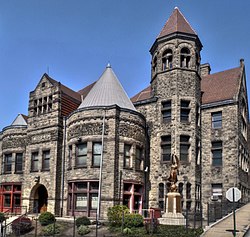Carnegie library
A Carnegie library is a library that was built with the help of money from Andrew Carnegie. Over 2,500 Carnegie libraries were built across the world. Between 1883 and 1919, Carnegie would give money to cities and towns to build a library. The cities or towns would have to give a place to build the library, and promise to give 10% of the cost of the library's construction each year for the library's costs. Many Carnegie library buildings still stand. Some are used for other purposes now. Most are made of brick. They often have a staircase leading up to the front door.
Carnegie Library Media
Andrew Carnegie, c. 1905, National Portrait Gallery
Plaque at the Taunton Public Library in Massachusetts
Carnegie Free Library of Braddock in Braddock, Pennsylvania, built in 1888, was the first Carnegie Library in the United States to open (1889) and the first of four to be fully endowed.
Carnegie laying the foundation stone of the Waterford City Library (1903)
The Historical Society of Washington, D.C. is located in a former Carnegie library and is on the U.S. National Register of Historic Places.
Carnegie Library, built in 1901 in Guthrie, Oklahoma









